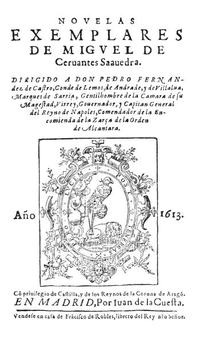- Novelas ejemplares
-
Exemplary Novels 
1613 edition, with the now archaic spelling "exemplares".Author(s) Miguel de Cervantes Original title 'Novelas exemplares' Country Spain Language Spanish Genre(s) Short story collection Publisher Juan de la Cuesta The Exemplary Novels (Spanish: Novelas ejemplares) are a series of short stories by Miguel de Cervantes. Written between 1590 and 1612, the collection was published in Madrid in 1613 by Juan de la Cuesta, and received well in the wake of the first part of Don Quixote. These are twelve short novels that follow the model established in Italy. Although they are actually long short stories, they are termed novels by Cervantes. Cervantes boasted in his foreword to have been the first to write novels in the Spanish language:
My genius and my inclination prompt me to this kind of writing; the more so as I consider (and with truth) that I am the first who has written novels in the Spanish language, though many have hitherto appeared among us, all of them translated from foreign authors. But these are my own, neither imitated nor stolen from anyone; my genius has engendered them, my pen has brought them forth, and they are growing up in the arms of the press.[1]
They are usually grouped into two series: those characterized by an idealized nature and those of a realistic nature. Those idealized in nature, which are the closest to the Italian influence, are characterized by arguments dealing with amorous entanglements, by improbable plots, by the presence of idealized characters and psychological development, and the low reflection of reality. They include: El amante liberal, Las dos doncellas, La española inglesa, La señora Cornelia and La fuerza de la sangre. The realistic in nature cater to the descriptions of realistic characters and environments, with intentional criticism in many cases. The realistic in nature are the best known stories: Rinconete y Cortadillo, El licenciado Vidriera, La Gitanilla, El casamiento engañoso (which leads directly into the fantasy El coloquio de los perros), and La ilustre fregona. However, the separation between the two groups is not sharp and elements of the idealistic may be found in some of the realistic novels.
Since there are multiple versions of some of these stories, it is believed that Cervantes introduced some variations in these novels for moral, social and aesthetic purposes (hence the name 'exemplary'). The more primitive version is found in the manuscript called the de Porras de la Cámara, a miscellaneous collection of various literary works which include a novel usually attributed to Cervantes, La tía fingida. On the other hand, some short stories are also embedded in Don Quixote, as El curioso impertinente or Historia del cautivo which have autobiographical elements. In addition, it alludes to another novel already composed, Rinconete y Cortadillo.
The short stories
- La Gitanilla
- El amante liberal
- Rinconete y Cortadillo
- La española inglesa
- El licenciado Vidriera
- La fuerza de la sangre
- El celoso extremeño
- La ilustre fregona
- Las dos doncellas
- La señora Cornelia
- El casamiento engañoso
- El coloquio de los perros
The complete collection of Exemplary Novels is seldom published today, at least in English. There have been two paperback editions of the novels over the past fifteen years, both termed Exemplary Stories rather than novels, but neither of them included all of the stories.[2][3]
Notes and references
- ^ Cervantes Saavedra, Miguel de. "E-book of The Exemplary Novels of Cervantes (Translated by Walter K. Kelly)". The Project Gutenberg. http://www.gutenberg.org/files/14420/14420-8.txt. Retrieved 2008-11-04.
- ^ http://www.amazon.com/dp/0140442480
- ^ http://www.amazon.com/dp/0192832433
External links
- The Novelas and the Fairy Tale: http://tel.archives-ouvertes.fr/docs/00/11/65/92/PDF/These_DARNIS.pdf
Categories:- Spanish short stories
- Spanish literature
- 1613 short story collections
- Short story collections by Miguel de Cervantes
Wikimedia Foundation. 2010.
